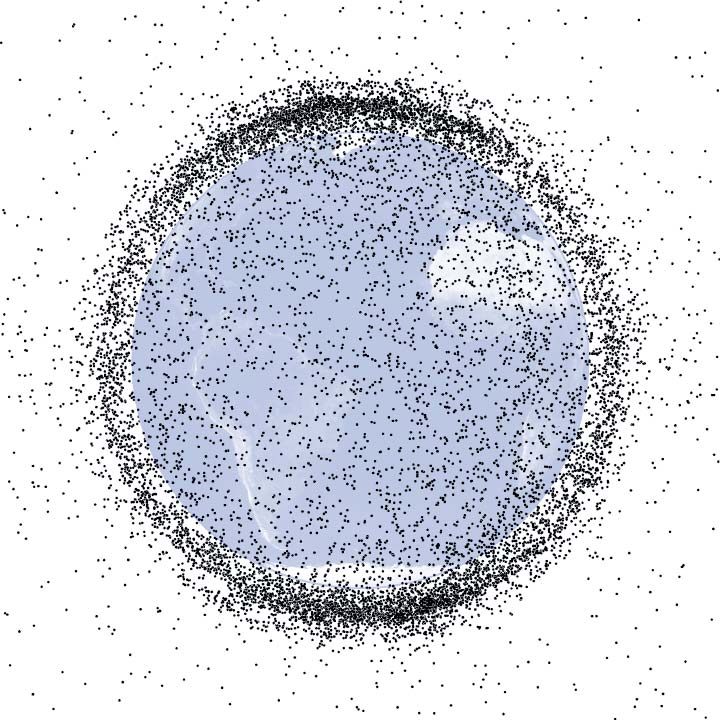Space Station Crew Avoids Close Shave with Space Junk

Three spaceflyers aboard the International Space Station are safely out of harm's way and will not need to take shelter from a possible collision with a piece of space junk, NASA officials said today (Nov. 23).
After careful analysis late Tuesday (Nov. 22), flight controllers at NASA's Johnson Space Center in Houston called off plans for the three space station residents to board their Russian-built Soyuz space capsules to protect themselves from a possible collision with the orbital debris.
"Further tracking data confirmed that the debris poses no threat to the station or the crew," NASA officials said in a statement.
Station commander Dan Burbank of NASA and Russian cosmonauts Anton Shkaplerov and Anatoly Ivanishin were woken up at 1 a.m. EST (0600 GMT) today and informed that the orbital debris was no longer an issue, agency officials said.
Exhilarating start to the mission
Mission controllers had been monitoring a piece of shrapnel from a Chinese weather satellite that was destroyed in 2007, as it looked to be on course to come near the orbiting outpost. [Worst Space Debris Events of All Time]
The object, which is about 4 inches (10 centimeters) in diameter, was initially predicted to come within 2,800 feet (850 meters) of the station early this morning. The agency refers to these close shaves as "conjunctions."
Breaking space news, the latest updates on rocket launches, skywatching events and more!
As better tracking data became available, officials at Mission Control downgraded the threat.
The potential conjunction made for a chaotic start for the three space station crewmembers, who only arrived at the orbiting laboratory one week ago to begin their months-long mission.
Three other spacecflyers — NASA's Mike Fossum, Japanese astronaut Satoshi Furukawa and Russian cosmonaut Sergei Volkov — recently completed their turns on the station and landed in Kazakhstan on Monday (Nov. 21).
Debris in orbit
If space junk is on track to fly within a predetermined pizza box-shaped zone around the space station, NASA and its partners will direct the crew to seek shelter aboard their Soyuz spacecraft, which are continually docked at the outpost, in case they need to make a speedy escape.
The last time spaceflyers had to make such a maneuver was on June 28, 2011, when a piece of unknown space debris came within 850 feet (260 meters) of the space station. That was only the second time in history that the station crew has had to take shelter from space debris.
But space junk is a growing problem. Spent rocket stages, lost spacewalking tools, broken satellites and pieces of destroyed satellites are all clogging the orbital corridors of space. There is so much trash up there, in fact, that even if no more were added, it will collide with itself to continually produce more and more, scientists say.
Certain events, such as the 2007 event when China intentionally destroyed a defunct weather spacecraft in an anti-satellite test, have contributed greatly to the total amount of space debris.
Even though most pieces of space junk are much smaller than the football field-size space station, if an object traveling at 17,000 miles per hour (28,000 km per hour) collided with the outpost, it could do devastating damage.
Follow SPACE.com for the latest in space science and exploration news on Twitter @Spacedotcom and on Facebook.

Space.com is the premier source of space exploration, innovation and astronomy news, chronicling (and celebrating) humanity's ongoing expansion across the final frontier. Originally founded in 1999, Space.com is, and always has been, the passion of writers and editors who are space fans and also trained journalists. Our current news team consists of Editor-in-Chief Tariq Malik; Editor Hanneke Weitering, Senior Space Writer Mike Wall; Senior Writer Meghan Bartels; Senior Writer Chelsea Gohd, Senior Writer Tereza Pultarova and Staff Writer Alexander Cox, focusing on e-commerce. Senior Producer Steve Spaleta oversees our space videos, with Diana Whitcroft as our Social Media Editor.

